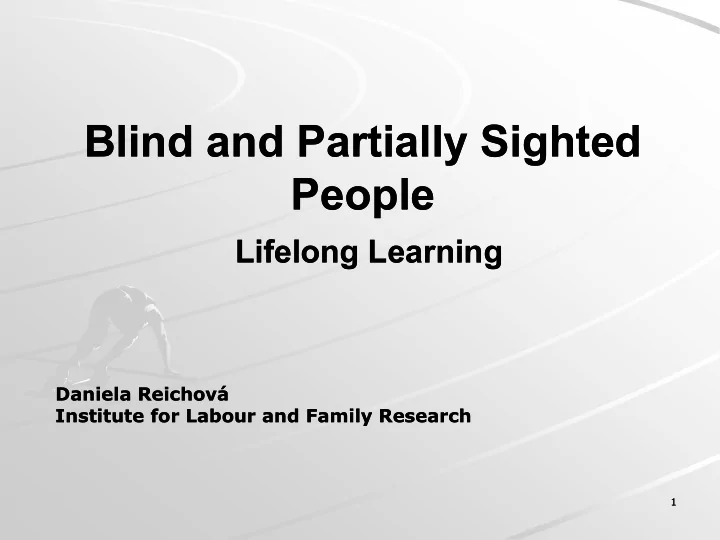

Blind and Partially Sighted Blind and Partially Sighted People People Lifelong Learning Lifelong Learning Daniela Reichová Daniela Reichová Institute for Labour and Family Research Institute for Labour and Family Research 1 1
Structure of Respondents by Achieved Education Structure of Respondents by Achieved Education Without Education % 20 40 60 0 Primary Apprenticeship Full Secondary Vocational Working Full Secondary General Unemployed Post-secondary Tertiary (College, University Neodpovedal 2 2
Type of Type of schools schools Primary Primary Secondary Secondary School School School School Working Working (%) (%) (%) (%) Integrated Integrated 46,4 46,4 36,4 36,4 School School Special School Special School 53,2 53,2 62,5 62,5 Integrated and Integrated and 0,4 0,4 1,1 1,1 Special Sch. Special Sch. Primary Primary Secondary Secondary School School School School Unemployed Unemployed (%) (%) (%) (%) Integrated Integrated 77 77 65 65 School School Special School Special School 23 23 35 35 3 3
Further education Further education Participation in social rehabilitation 80 % 60 Yes 40 No 20 0 Working Unemployed 4 4
Participation in further education and training at present or past employer 100 % 75 50 25 0 Working Unemployed Yes No 5 5
Education and training for labour market 60 % 48 36 24 12 0 Working Unemployed Yes No 6 6
Language Language Skills Skills Not sufficient at primary and secondary education Not sufficient at primary and secondary education Higher level of foreign language proficiency in the sample of working Higher level of foreign language proficiency in the sample of working respondents respondents Educational barriers in integrated language courses Educational barriers in integrated language courses Low level of language skills Low level of language skills „No ability to speak“ the most common level of language proficiency „No ability to speak“ the most common level of language proficiency Higher level of foreign language proficiency in the sample of working Higher level of foreign language proficiency in the sample of working respondents respondents In both samples the respondents with higher level In both samples the respondents with higher level of of education declared education declared higher level of language proficiency. higher level of language proficiency. More women than men declared speaking foreign language on higher More women than men declared speaking foreign language on higher level. level. 7 7
Computer Skills Computer Skills Face the educational barriers in integrated computer Face the educational barriers in integrated computer courses of further education and training courses of further education and training Higher level of computer skills among working respondents. Higher level of computer skills among working respondents. Mostly user skills of MS Word, MS Excel and Internet on Mostly user skills of MS Word, MS Excel and Internet on higher level among working respondents higher level among working respondents MS Word: lowest number of respondents in both samples MS Word: lowest number of respondents in both samples has no skills (working has no skills (working – 47%, unemployed 47%, unemployed – 61). 61). More men than women declared ICT skills on higher level. More men than women declared ICT skills on higher level. 8 8
Barriers of Education Barriers of Education Working: two thirds, Unemployed: two fifth do not Working: two thirds, Unemployed: two fifth do not feel the necessity of further education. feel the necessity of further education. Unemployed: More than one third Unemployed: More than one third - education does education does not help to find a job and this is the reason of their not help to find a job and this is the reason of their disinterest. disinterest. The big problem the courses remoteness and The big problem the courses remoteness and difficult transportation. difficult transportation. Offered courses and courses of their interest not Offered courses and courses of their interest not suitable for VIP. suitable for VIP. The vast majority in both samples considers The vast majority in both samples considers education as very important and important for education as very important and important for getting and keeping the job. getting and keeping the job. 9 9
Educational Tools Educational Tools acoustic recordings, acoustic recordings, compensation aids compensation aids electronic documents. electronic documents. space without architectonical space without architectonical barriers barriers car (commuting service) car (commuting service) 10 10
Further Education Future Interest Further Education Future Interest Differences between two samples. Differences between two samples. Working respondents: Working respondents: Unemployed Unemployed respondents: respondents: improve knowledge improve knowledge and skills from the and skills from the courses of massage courses of massage field of their work and field of their work and therapist. therapist. interest (social interest (social learn or improve their learn or improve their science, accounting, science, accounting, key qualifications (ICT key qualifications (ICT gardening, music, arts gardening, music, arts skills, language skills) skills, language skills) and crafts). and crafts). self-employment self employment Occasionally there Occasionally there knowledge and skills. knowledge and skills. were some were some no respondents who no respondents who respondents who want respondents who want wanted to raise their wanted to raise their to achieve higher to achieve higher qualification despite qualification despite qualification. qualification. the low educational the low educational level achieved. level achieved. 11 11
Summary Summary Low education level in both samples Low education level in both samples Higher proportion of working respondents in Higher proportion of working respondents in tertiary education tertiary education Higher participation in further education and Higher participation in further education and training training Better language and computer skills of employed Better language and computer skills of employed The most common barrier declared: remoteness, The most common barrier declared: remoteness, courses not suitable courses not suitable Interest in computer courses (both), massage Interest in computer courses (both), massage therapist (U), self therapist (U), self-employment courses (U), field employment courses (U), field of work courses (W), raising education level (W) of work courses (W), raising education level (W) 12 12
Recommend
More recommend